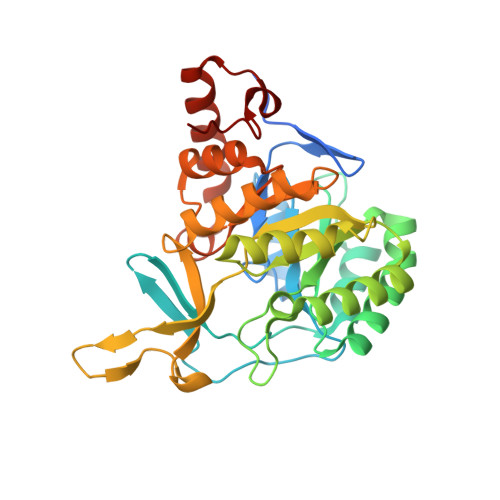Crystal structures of FMN-bound and FMN-free forms of dihydroorotate dehydrogenase fromTrypanosoma brucei.
Kubota, T., Tani, O., Yamaguchi, T., Namatame, I., Sakashita, H., Furukawa, K., Yamasaki, K.(2018) FEBS Open Bio 8: 680-691
- PubMed: 29632820
- DOI: https://doi.org/10.1002/2211-5463.12403
- Primary Citation of Related Structures:
5XFV, 5XFW - PubMed Abstract:
Dihydroorotate dehydrogenase (DHODH) is a flavin-binding enzyme essential for pyrimidine biosynthesis, which converts dihydroorotate to orotate. Three-dimensional structures of cytosolic DHODH of parasitic protozoa are of interest in drug discovery for neglected tropical diseases, especially because these enzymes possess significantly different structural and functional properties from the membrane-associated human enzyme. The existing crystal structures of the flavin mononucleotide (FMN)-bound DHODHs reveal a number of interactions stabilizing FMN. However, to understand the binding mechanism correctly, it is necessary to compare the structures of the FMN-bound and FMN-free forms, because the protein moiety of the former is not necessarily the same as the latter. Here, we prepared the FMN-free DHODH of Trypanosoma brucei using an Escherichia coli overexpression system. Although this apoform lacks enzymatic activity, simple incubation with FMN activated the enzyme. It was stable enough to be crystallized, enabling us to determine its structure by X-ray crystallography at 1.6 Å resolution. We also determined the FMN-bound form at 1.8 Å resolution. Although the two structures have essentially the same scaffold, we observed flipping of a peptide-bond plane in the vicinity of the FMN-binding site, accompanied by an alternative hydrogen-bonding pattern. Comparisons of B factors of the protein main chain revealed that binding of FMN decreased flexibility of most of the residues at the FMN-binding site, but increased flexibility of a lid-like loop structure over the active center. This increase was ascribed to a conformational change in an FMN-contacting residue, Asn195, which induced a rearrangement of a hydrogen-bond network of the residues comprising the lid.
- Biomedical Research Institute National Institute of Advanced Industrial Science and Technology (AIST) Tsukuba Japan.
Organizational Affiliation:


















